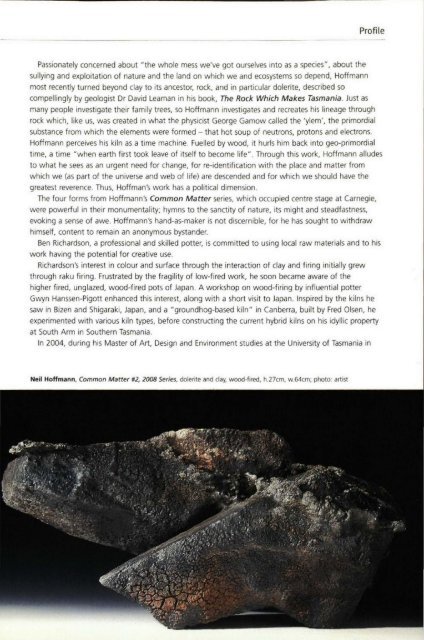The Journal of Australian Ceramics Vol 48 No 3 November 2009
Create successful ePaper yourself
Turn your PDF publications into a flip-book with our unique Google optimized e-Paper software.
Pr<strong>of</strong>ile<br />
Passionately concerned about "the whole mess we've got ourselves into as a species", about the<br />
sullying and exploitation <strong>of</strong> nature and the land on which we and ecosystems so depend, H<strong>of</strong>fmann<br />
most recently turned beyond clay to its ancestor, rocK, and in particular dolerite, described so<br />
compellingly by geologist Dr David Leaman in his book, <strong>The</strong> Rock Which Makes Tasmania . Just as<br />
many people investigate their family trees, so H<strong>of</strong>fmann investigates and recreates his lineage through<br />
rock which, like us, was created in what the physicist George Gamow called the 'ylem', the primordial<br />
substance from which the elements were formed - that hot soup <strong>of</strong> neutrons, protons and electrons.<br />
H<strong>of</strong>fmann perceives his kiln as a time machine. Fuelled by wood, it hurls him back into geo-primordial<br />
time, a time "when earth first took leave <strong>of</strong> itself to become life". Through this work, H<strong>of</strong>fmann alludes<br />
to what he sees as an urgent need for change, for re-identification with the place and matter from<br />
which we (as part <strong>of</strong> the universe and web <strong>of</strong> life) are descended and for which we should have the<br />
greatest reverence. Thus, H<strong>of</strong>fman's work has a political dimension.<br />
<strong>The</strong> four forms from H<strong>of</strong>fmann's Common Matter series, which occupied centre stage at Carnegie,<br />
were powerful in their monumentality; hymns to the sanctity <strong>of</strong> nature, its might and steadfastness,<br />
evoking a sense <strong>of</strong> awe. H<strong>of</strong>fmann's hand-as-maker is not discernible, for he has sought to withdraw<br />
himself, content to remain an anonymous bystander.<br />
Ben Richardson, a pr<strong>of</strong>essional and skilled potter, is committed to using local raw materials and to his<br />
work having the potential for creative use.<br />
Richardson'S interest in colour and surface through the interaction <strong>of</strong> clay and firing initially grew<br />
through raku firing. Frustrated by the fragility <strong>of</strong> low-fired work, he soon became aware <strong>of</strong> the<br />
higher fired, unglazed, wood-fired pots <strong>of</strong> Japan, A workshop on wood-firing by influential potter<br />
Gwyn Hanssen-Pigott enhanced this interest, along with a short visit to Japan. Inspired by the kilns he<br />
saw in Bizen and Shiga raki, Japan, and a "groundhog-based kiln" in Canberra, built by Fred Olsen, he<br />
experimented with various kiln types, before constructing the current hybrid kilns on his idyllic property<br />
at South Arm in Southern Tasmania.<br />
In 2004, during his Master <strong>of</strong> Art, Design and Environment studies at the University <strong>of</strong> Tasmania in<br />
Neil H<strong>of</strong>fmann, Common Matter .2. 2008 Series. dolerite and clay, wood-fired, h.27cm. w.64cm; photo: artist


















